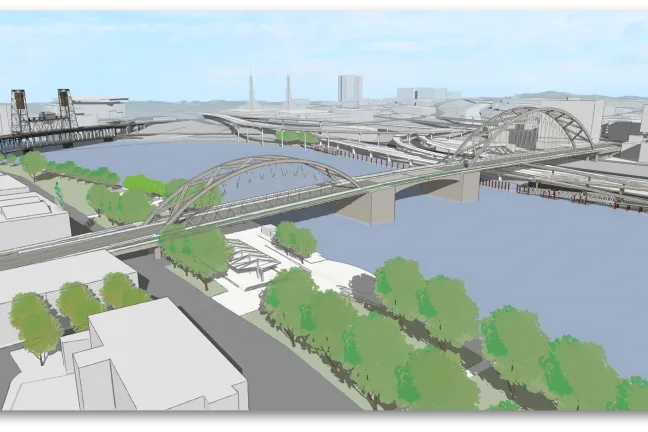The Community Task Force for the Earthquake Ready Burnside Bridge project recommended a new
The long span bridge alternative would replace the existing bridge in the same location and alignment. The long span alternative has the fewest support columns of four alternatives that were studied. Fewer columns avoids costly construction in geotechnical hazard zones near the Willamette River and restricted spaces between lanes of Interstate 5 and the Union Pacific Railroad tracks on the east side. Task force members cited these reasons for choosing the long span alternative:
- Locating fewer columns in liquefiable soils gives it the least risk from soil movement during an earthquake
- It is the lowest cost of four build alternatives ($825 million compared to as high as $950 million for the most expensive option)
- The reduced number of columns also benefits Waterfront Park users, crime prevention, and preservation of the Burnside Skatepark
- Additional deck width over the river provides a safer facility for bicyclists, pedestrians and other users
- Reduced impacts to natural resources due to fewer columns in the river
Several task force members asked the project team to explore ways to mitigate the long span’s impacts on views, since it will require a superstructure above the bridge deck to support the longer horizontal span. Questions of the structure’s scale and relation to adjacent neighborhoods will be dealt with in the Bridge Type Selection phase which begins this fall, and during final design.
Task force members also recommended that the project not include a temporary bridge to carry some traffic while the old bridge is removed and a new bridge is built. The temporary bridge would cost about $90 million and would only carry between a third and half of existing bridge traffic. Task force members felt that the minimal time savings the temporary bridge would provide did not justify its cost, additional in-water impacts, and the extra two years of construction it would require.
The public will have a chance to weigh in on the task force’s recommendations in August through an online open house and survey. The task force recommendation and public input will be presented to the project’s Policy Group on October 2 when that group of elected and appointed leaders will vote on the preferred alternative.
Federal law requires that a Draft Environmental Impact Statement be prepared and another comment period be offered in 2021 before the preferred alternative can be approved by the Federal Highway Administration in 2021. The Multnomah County Board of Commissioners will also vote on the preferred alternative.
The bridge type selection process will begin this fall and be completed in 2021. If the long span option is adopted, a bridge type with a superstructure above the bridge deck, such as a tied arch (like the Fremont Bridge) or cable-stayed (like the Tilikum Crossing), will be needed. Design work will stretch from 2021-2024 with construction starting in 2024 and lasting roughly four and a half years.
The project has studied four build alternatives that would create a resilient lifeline crossing over the Willamette River in the event of a major earthquake, and several temporary bridge options. The other build alternatives are:
- An enhanced seismic retrofit of the existing bridge
- A replacement movable bridge on the same alignment with short spans
- A replacement movable bridge with an extension of NE Couch Street
Task force members represent residential areas, business districts, and interests including auto commuters, transit users, freight, pedestrians, bicyclists, bridge history, social service agencies, and other organizations based near the bridge.
Multnomah County maintains the Burnside Bridge and leads the Earthquake Ready Burnside Bridge project. For more information or to sign up for email notifications, visit www.burnsidebridge.org.

